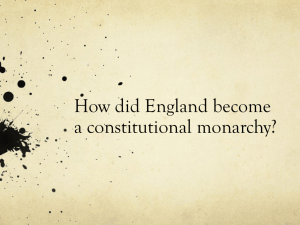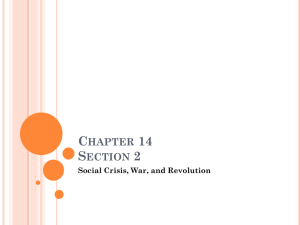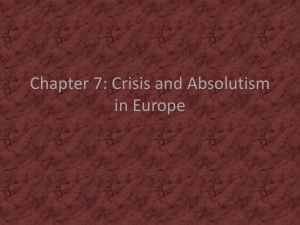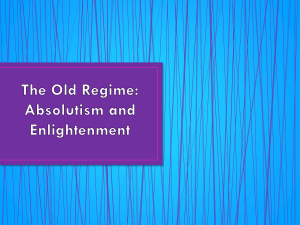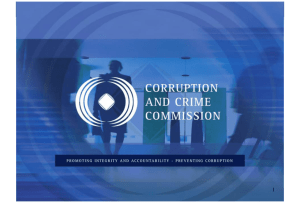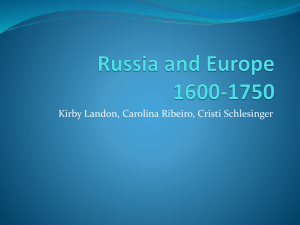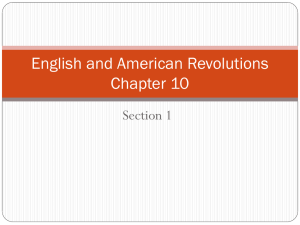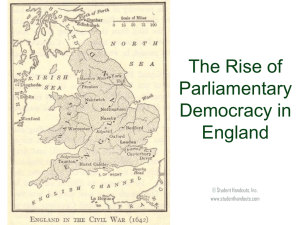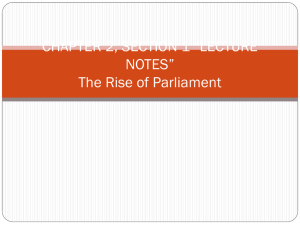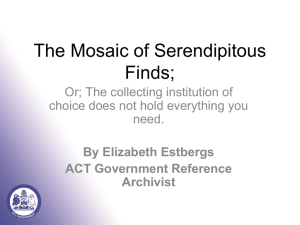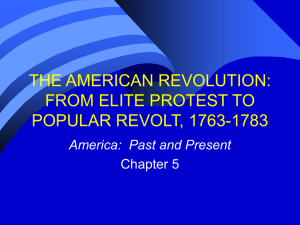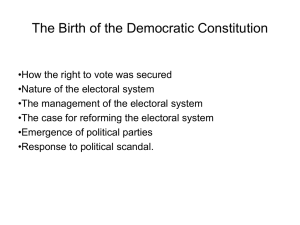Period 4 British Constitutionalism
advertisement
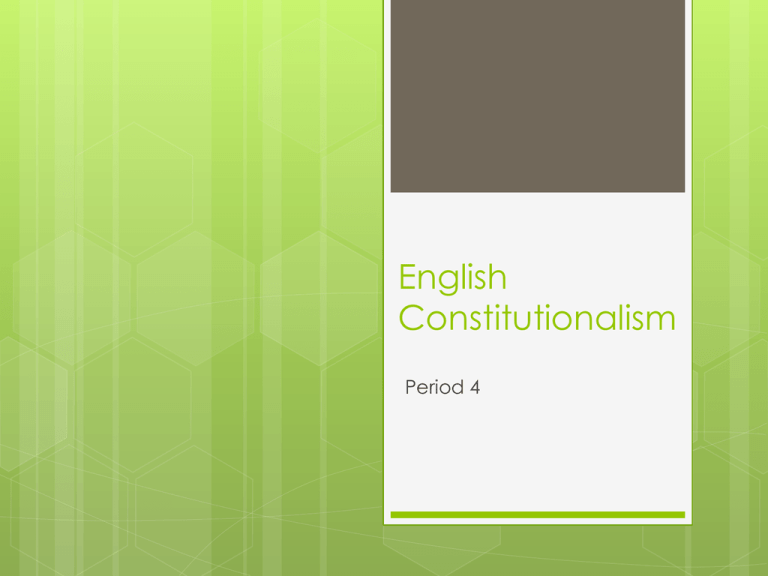
English Constitutionalism Period 4 The political influence that society had during the 17th century Question One Kali Hoying An Overview of Social Classes in England Nobility Gentry Yeomen Craftsmen, tenant farmers, and laborers An Overview of Political Structure in England King/Queen Parliament House of Lords House of Commons House of Lords Made up of nobility and superior clergy Appointed Usually hereditary Possess veto power House of Commons Made up mostly of landed gentry Elected Given the say over all measures to initiate taxation Women Could not vote Could not hold an office Discouraged from expressing their political views in public Indirectly influenced politics Sources Lambert, Tim. "A BRIEF HISTORY OF ENGLISH SOCIETY." A WORLD HISTORY ENCYCLOPEDIA. N.p., n.d. Web. 24 Oct 2012. <http://www.localhistories.org/society.html>. "Motivating People to Find a Good Government." The Religious and Civil Wars Continued: What’s War Good For?. N.p.. Web. 24 Oct 2012. <http://www.advancedplacementhistory.com/Euronotes Constitutionalism in England and Netherlands.htm>. "Constitutionalism in Western Europe: c. 1600-1725."HistorySage.com. HistorySage.com, n.d. Web. 24 Oct 2012. <http://www.auburnschools.org/ahs/rcummins/AP Euro/Assignment Calendar/5-Absolutism & Constitutionalism/7westernconstitutionalism.pdf>. Stip, Roger. Unit 3.2: 1 English Society in the 17th Century.WMV. 2011. Video. Youtube.comWeb. 29 Oct 2012. <http://www.youtube.com/watch?v=dp_xZDulNCc>. The Political Problems of the 17 century leading up to the English Civil War Whitney Longenecker Question 2 Political Problems King and Parliament struggled to determine each other’s role in government James I came into power after Elizabeth's death, exercising the divine right of kings and alienating Parliament. Religious controversies between the Anglican Church and Puritans. Charles I and Parliament Parliament passed the Petition of Right, which prohibited the monarch from taxing the people without Parliament’s consent. Charles I accepted it at first, but later realized how much it limited his power, and decided since he could not work with the Parliament, he would not summon it to meet at all. Charles I Religious Policy Charles I married a Catholic woman, Henrietta Maria, from France, which aroused suspicion for his religious preference. Tried to introduce more ritual to the Anglican church; Puritans believed it was a return to Catholicism. Charles I Religious Policy Attempted to impose the Anglican Book of Common Prayer on the Scottish Presbyterian church, who rose up in rebellion against the king. Charles I was forced to summon Parliament because he did not have the funds to raise an army in order to defend against the Scots. This was their first meeting in 11 years. Charles I vs. Parliament Limited royal authority in their first session. Abolished arbitrary court and taxes imposed without Parliaments consent. Pushed for the elimination of bishops in the Anglican church. Charles I tried to arrest some of the more radical Parliament members such as John Pym and his fellow Puritans. The Start of the Civil War Because Charles I had tried to arrest members of Parliament without any justification to any crimes, Parliament came to the agreement that the king had over stepped his bounds, and England slipped into a civil war. Sources Walwyn, William. "Lecture 7: The English Civil War." The History Guide. N.p., 3 Aug. 2009. Web. 27 Oct. 2012. "The Causes of the English Civil War." The History Learning Site. N.p., n.d. Web. 27 Oct. 2012. Events of the English Civil War Mike Setzer The English Civil War The English Civil war was a series of conflicts in England between Parliamentarians and Royalists. The Parliamentarians Supporters of the English Parliament. Also known as Roundheads. Led by Oliver Cromwell. Wanted to bring more power to the English Parliament and remove power from the monarch. The Royalists Supporters of King Charles I and Charles II. Also known as Cavaliers. Sought to keep power with the Monarch. (King Charles I) Events – Start of the War 1642 – King Charles raises his standard at Nottingham signaling the start of the war. Royalists won most of the early battles routing the Parliamentarians until 1644. Events – New Model Army 1645 – Cromwell created the “New Model Army” Army ranks are based upon skill and ability rather than social class. Becomes modern military system. Leads to success for the Parliamentarians. Events – End of the 1st Civil War 1646 – King Charles I is captured by the Parliamentarian army. King Charles I escapes and seeks help from the Scots. This signals the start of the Second Civil War. Events – End of the 2nd Civil War 1649 – King Charles is captured by the Parliamentarian army. He is beheaded and the Parliamentarians claim victory over the second civil war. Sources Wallwyn, William. "Lecture 7: The English Civil War." History Guide. N.p., 03 2009. Web. 28 Oct 2012. <http://www.historyguide.org/earlymod/lecture7c.html>. "The English Civil War." History Learning Site. N.p., n.d. Web. 27 Oct 2012. <http://www.historylearningsite.co.uk/english_civil-war.htm>. 5. The Impact of the Glorious Revolution on the Creation of New Acts Tayler Shreve What is the Glorious Revolution? Also called the Revolution of 1688 or the Bloodless Revolution 1688-1689 Constitutional crisis resolved through legislation Came at the end of a reign when James II had made it evident that he wanted Roman Catholicism reinstalled as the country’s religion Parliament engineered the ouster of the legitimate male line of the Stuart Kings Imported a new Protestant king and queen William III and Mary II William III and Mary II What Did The Glorious Revolution Do? "established an elected Parliament as supreme in the fundamentals of taxation and legislation and set clear limits to royal power.“ Established the victory of Parliament over the King Various contested issues of power were resolved in favor of Parliament Parliament had to be convened regularly All new taxes had to be approved by Parliament New political arrangements were made with Scotland English Convention Parliament 1689 Met amid the confusion created by James’s flight In February, the Convention agreed that James had “abdicated the government and that the throne has thereby become vacant.” The leaders of the Convention prepared the Declaration of Rights to be presented to William and Mary James II Bill of Rights 1689 Conservative document passed into law Established the principle that only a Protestant could wear the crown of England A new coronation oath required the monarch to uphold Protestantism and the statutes, laws, and customs of the realm as well Had a major political bent to it that handed a great deal of power to Parliament Some historians view it as the start of constitutional monarchy Bill of Rights Declared that James had abdicated and that the Crown had legally passed to William and Mary and their heirs Forbade the monarch from being a Catholic and from marrying a Catholic Taxation raised through anything else other than Parliament was banned A standing army raised without Parliament’s consent was banned The prosecution of anyone petitioning the Crown was banned Mutiny Act March 1689 Gave the monarch the legal means to maintain army discipline but Parliament had to support this every six months at a time This was later increased to a year Restrained the monarch’s control over military forces in England by restricting the use of martial law Passed for one year only When it lapsed between 1698 and 1701, the crown’s military power was not appreciably affected Toleration Act May 1689 Did not introduce classic religious toleration Exempted Dissenters from certain laws The Toleration Act permitted most forms of Protestant worship Unitarians were explicitly excluded, as were Catholics and Jews. Allowed freedom of worship but not full citizenship except Catholics and Unitarians Test and Corporation acts were still in force. Originally intended to be part of a new comprehensive religious settlement in which most mainline Dissenters would be admitted into the church This failed for the same reasons that comprehension had been failing for 30 years the Anglican clergy would not give up its monopoly Dissenters would not compromise their principles Triennial Act December 1694 No Parliament should exceed three years No dissolution of Parliament should be longer than three years Reluctantly agreed to by Charles I Stated that there had to be a parliament of at least 50 days duration every three years It was designed to prevent a repetition of the long absences of parliament Said it reduced his sovereign powers Seen in the '11 Years Tyranny' of 1629-1640. It was never used Parliaments after the Civil War greatly moderated it At least recognized the importance of parliament in the government of the country Civil List Act December 1698 Provided the Crown with money to pay for its existence as well as financing extraordinary expenditure such as wars Previously these expenses had been paid entirely from the monarch’s hereditary revenues and from certain taxes voted to the sovereign for life by Parliament During the reign of George I, the Civil List became a fixed sum, with Parliament paying any debts that were incurred For George II there were assigned revenues in addition to fixed grants and a guaranteed total of £800,000 George III made a political tool of his Civil List (at a fixed sum of £800,000), rewarding his supporters in Parliament with secret pensions and bribes. Parliament, in turn, sometimes used a sovereign’s dependence on the Civil List as a means of persuading him to give up other income or powers Act of Settlement June 1701 A piece of English legislation governing the succession to the English Crown It was passed in 1701 to amend the English Bill of Rights, following the death of the last child of the then Princess Anne The Act of Settlement wanted to clarify what would happen if Anne left no heirs The House of Hanover was Protestant and the act ensured that the Protestant faith would continue after Anne died Provides that only Protestant descendants of Sophia, who have not married a Roman Catholic, can succeed to the English Crown In addition, it specifies that it is for Parliament to determine who should succeed to the throne, not the monarch. Sophia died before Anne, so the result of the Act was the succession of Sophia’s son George in preference to many of his cousins. As a result of the Act of Settlement, several members of the British Royal Family who have converted to Roman Catholicism or married Roman Catholics have been barred from succeeding to the Crown, though since George I no individual has been excluded from the throne on the grounds of religion Sophia of Hanover Alien Act of 1705 A law passed by the English parliament as a response to the Scottish parliament's Act of Security of 1704 Provided that Scottish estates held in England were to be treated as alien property Also had an embargo on the import of Scottish products into England and English colonies Making inheritance much less certain About half of Scotland's trade, covering sectors such as linen, cattle and coal Contained a provision that it would be suspended if the Scottish entered into negotiations on the dispute between the two parliaments Achieved its aim, leading to the Act of Union 1707 uniting the two countries as Great Britain • • • 1707 Passed by the English and Scottish Parliaments Led to the creation of the United Kingdom of Great Britain • • • • May 1st, 1707 The UK Parliament met for the first time in October 1707 Scotland’s needed economic security and material assistance England’s needed political safeguards against French attacks and a possible Jacobite restoration – for which Scotland might serve as a conveniently open back door • • England’s ‘bargaining card’ was freedom of trade Scotland’s was acquiescence in the Hanoverian succession The Protestant succession was adopted Trade was to be free and equal throughout Great Britain and its dominions Subject to certain temporary concessions, taxation, direct and indirect, would also be uniform England compensated Scotland for undertaking to share responsibility for England’s national debt by payment of an equivalent of £398,085 Scots law and the law courts were to be preserved Scottish Parliament passed the treaty in January 1707 • • The royal assent was given on March 6 The union went into effect on May 1, 1707. • • • • • • – English passed it soon after Sources Primary Source: http://www.britannica.com/EBchecked/topic/615 557/United-Kingdom/44875/The-Revolution-of-1688 Secondary Sources: http://faculty.ucc.edu/eghdamerow/glorious_revolution.htm http://www.british-civilwars.co.uk/glossary/convention-parliament.htm http://www.historylearningsite.co.uk/1688_revoluti on.htm http://www.britannica.com/EBchecked/topic/119 308/Civil-List British Constitutionalism The British Cabinet of the 18th century Question 6 By: Amber Tilicky The British Cabinet The Cabinet developed during the 18th century as an inner committee of the Privy Council. It is composed of about 20 ministers chosen by the Prime Minister. The job of the Cabinet is to determine policy and ensure the control and co-ordination of government. The Privy Council was the chief source of executive power until the system of Cabinet government developed. Its main function these days is to advise the Sovereign. The Privy Council in 1837 Meetings of the Privy Council were normally held once each month wherever the Sovereign was residing at the time. What is the Cabinet? The Cabinet is the executive committee of Her Majesty's Privy Council, a body which has legislative, judicial and executive functions, and whose large membership includes members of the Opposition. The Cabinet is the ultimate decision-making body of the executive within the Westminster system of government in traditional constitutional theory Its decisions are generally implemented either under the existing powers of individual government departments, or by Orders in Council The political and decision-making authority of the cabinet has been gradually reduced over the last several decades, with some claiming its role has been usurped by a "prime ministerial“ government. Composed of the Prime Minister and some 22 Cabinet ministers, the most senior of the government ministers Within the Cabinet The Cabinet meets on a regular basis, usually weekly on a Thursday morning notionally to discuss the most important issues of government policy, and to make decisions The length of meetings varies according to the style of the Prime Minister and political conditions The Cabinet has numerous sub-committees which focus on particular policy areas, particularly ones which cut across several ministerial responsibilities, and therefore need coordination. These may be permanent committees or set up for a short duration to look at particular issues Sources "Top Sources." Office-Holders in Modern Britain: Volume 5. N.p., n.d. Web. 27 Oct. 2012. <http://www.britishhistory.ac.uk/source.aspx?pubid=75>. "Internet History Sourcebooks." Internet History Sourcebooks. N.p., n.d. Web. 27 Oct. 2012. <http://www.fordham.edu/halsall/mod/m odsbook06.asp>. British Constitutionalism By John Who has been sick But is now feeling better And has returned The British Constitution (or lack There is no written document for the British Constitution of) (referred to as “uncodified”) Acts of Parliament are the most though out parts, they are approved by the Monarch, the House of Lords, and The House of Commons. >These acts are sometimes used by the House of commons to overturn decisions by the House of Lords The doctrine of parliamentary sovereignty, the Magna Carta, and the Act of Settlement of 1701 have influenced many of the ideas Amendments are still made even though it is unwritten by a majority of support from both houses of parliament Bill of Rights (Unless under direction of Parliament) It is illegal to suspend or put into action any laws It is illegal to have a standing army during a time of peace Bill of Rights (Always illegal) Religious courts for (ecclesiastic causes) Levying money for the crown unless the same is given to parliament Removing rights to petition against the king Unfair or excessive fines, juries, or treatment while under conviction, The reinstatement of fines before conviction Bill of Rights (Granted Rights) Subjects are allowed to petition against the king Protestants were allowed to have guns when the Papists had already been building armies against them Speeches, debates, and proceedings cannot be questioned (freedom of speech) The election of parliament members ought to be free Sources Roland, John. "English Bill of Rights 1689." Constitution. Constitution Society, 10 Oct. 1997. Web. 30 Oct. 2012. <http://www.constitution.org/eng/eng_bor Trueman, Chris . "The British Constitution." History Learning Site. History learnng, n.d. Web. 30 Oct. 2012. <http://www.historylearningsite.co.uk/brit National Archives. "Bill of Rights (1688)."Legislation.gov.uk. The National Archives UK, n.d. Web. 30 Oct. 2012. <http://www.legislation.gov.uk/aep/Willan
